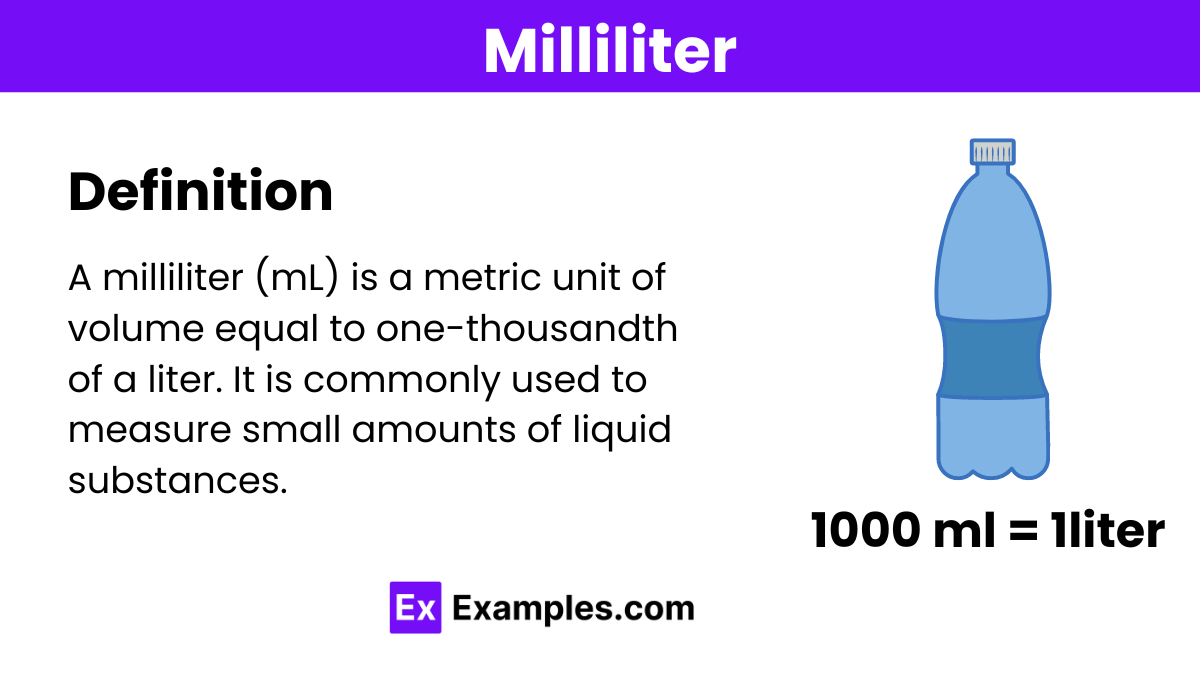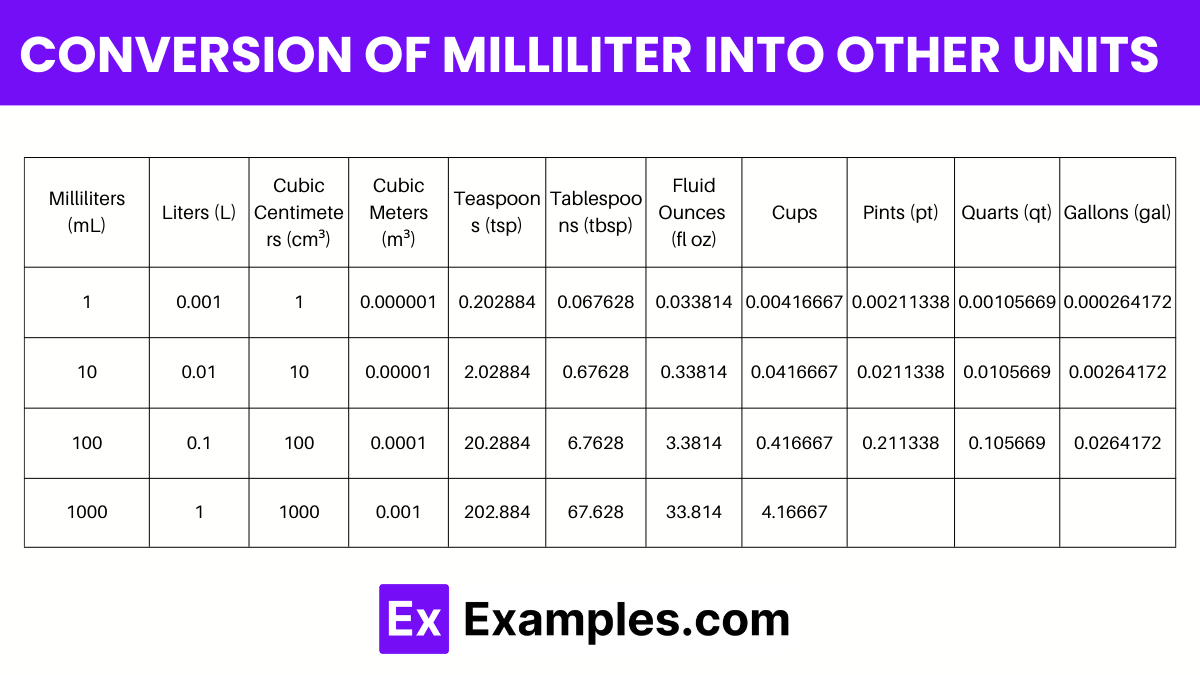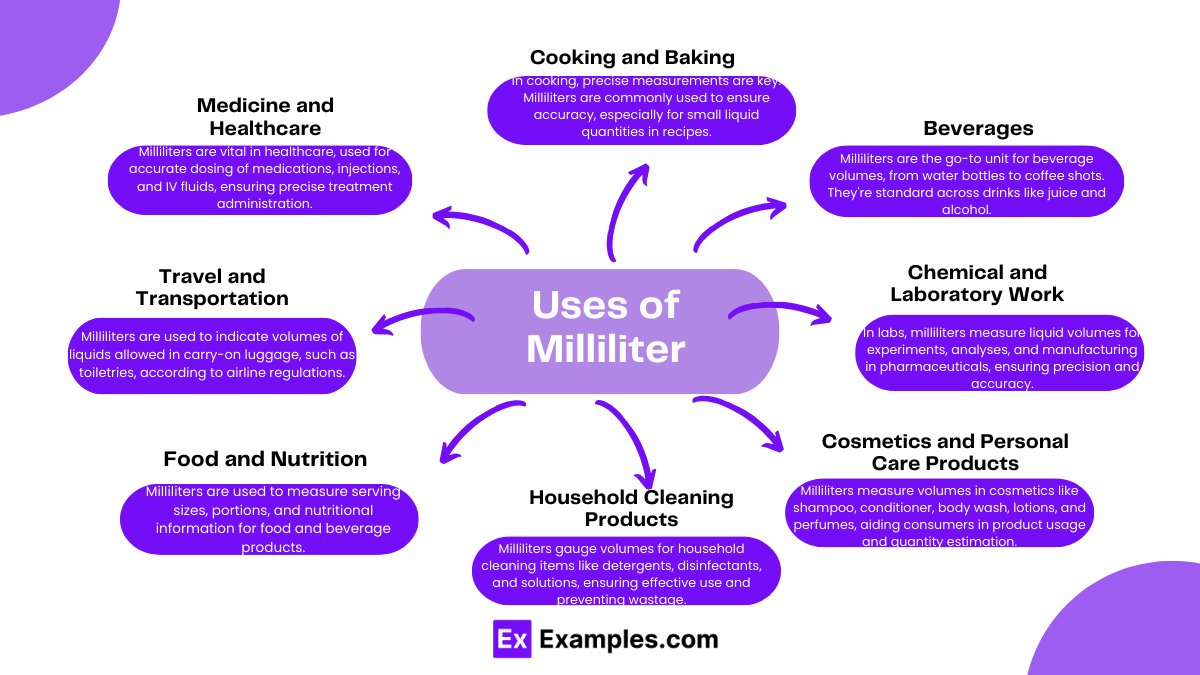What is the symbol for milliliter?
mL
ml
Lm
lM


A milliliter (mL) is a metric unit of volume equal to one-thousandth of a liter. It’s commonly used for measuring small quantities of liquids, such as medication doses, beverages, or cooking ingredients. One milliliter is approximately equivalent to one cubic centimeter (cc), making it a convenient unit for precise measurements.
A milliliter (mL) is a unit of volume in the metric system. It is equal to one-thousandth of a liter. Since the liter is the base unit of volume in the metric system, the milliliter is often used for measuring smaller volumes, such as liquids, medications, or chemical solutions.
In practical terms:
Cube or Rectangular Prism:
If the measurements are in centimeters, the volume will be in cubic centimeters (cm³), which are equivalent to milliliters (mL).
Cylinder:
Again, if your measurements are in centimeters, the volume will be in cubic centimeters (cm³), which are equivalent to milliliters (mL).
Sphere:
Once more, if your measurements are in centimeters, the volume will be in cubic centimeters (cm³), which are equivalent to milliliters (mL). To convert the volume from cubic centimeter to milliliters, you simply use the fact that 1 milliliter (mL) is equal to 1 cubic centimeter (cm³).
| Cube or Rectangular Prism | Volume = Length × Width × Height | Same as cubic centimeters (cm³) |
| Cylinder | Volume = 𝜋 × radius² × height | Same as cubic centimeters (cm³) |
| Sphere | Volume= 4/3 π × radius³ | Same as cubic centimeters (cm³) |

| Milliliters (mL) | Liters (L) | Cubic Centimeters (cm³) | Cubic Meters (m³) | Teaspoons (tsp) | Tablespoons (tbsp) | Fluid Ounces (fl oz) | Cups | Pints (pt) | Quarts (qt) | Gallons (gal) |
|---|---|---|---|---|---|---|---|---|---|---|
| 1 | 0.001 | 1 | 0.000001 | 0.202884 | 0.067628 | 0.033814 | 0.00416667 | 0.00211338 | 0.00105669 | 0.000264172 |
| 10 | 0.01 | 10 | 0.00001 | 2.02884 | 0.67628 | 0.33814 | 0.0416667 | 0.0211338 | 0.0105669 | 0.00264172 |
| 100 | 0.1 | 100 | 0.0001 | 20.2884 | 6.7628 | 3.3814 | 0.416667 | 0.211338 | 0.105669 | 0.0264172 |
| 1000 | 1 | 1000 | 0.001 | 202.884 | 67.628 | 33.814 | 4.16667 |
One milliliter is equal to 0.001 liters, liter a conversion used to express smaller liquid volumes in the metric system.
One milliliter is equivalent to one liter, making it useful for precise measurements and conversions within the metric system.
One milliliter equals 0.000001 cubic meters, cubic meter a conversion used to express small liquid volumes in metric units.
One milliliter equals approximately 0.202884 teaspoons, a conversion commonly used for precise measurements in cooking and baking.
One milliliter is equivalent to approximately 0.067628 tablespoons, commonly used in culinary measurements for small liquid volumes.
One milliliter equals approximately 0.033814 fluid ounces, commonly used for precise measurements of liquids in the US.
One milliliter is approximately equal to 0.00416667 cups, a conversion often used for smaller liquid measurements.
One milliliter is equivalent to approximately 0.00211338 pints, a conversion commonly used for small liquid volumes.
One milliliter equals approximately 0.00105669 quarts ,quarts a small fraction useful for precise liquid measurements in everyday tasks.
One milliliter equals approximately 0.000264172 gallons, gallon often used for precise measurements of liquid volumes in smaller quantities.

To find out how many 250 mL containers are in 1 liter, you divide the volume of 1 liter by the volume of each container.
1 liter is equal to 1000 milliliters (since 1 liter = 1000 mL).
So, to find out how many 250 mL containers are in 1 liter:
Number of 250 mL containers=1000 mL/250 mL/container
Number of 250 mL containers=4
Therefore, there are 4 containers of 250 mL each in 1 liter.
A meter (m) is a unit of length, whereas a milliliter (mL) is a unit of volume. These two units measure entirely different physical quantities, so there is no direct conversion between them without additional information.
However, if you’re referring to cubic meters (m³), which is a unit of volume, then there are 1,000,0001,000,000 milliliters (mL) in one cubic meter (m³).
This conversion is because: 1 cubic meter (m3)=1,000,000 cubic centimeters (cm3)=1,000,000 milliliters (mL)1 cubic meter (m3)=1,000,000 cubic centimeters (cm3)=1,000,000 milliliters (mL)
To find out how many 500 mL containers are in 1 liter, you divide the volume of 1 liter by the volume of each container.
1 liter is equal to 1000 milliliters (since 1 liter = 1000 mL).
So, to find out how many 500 mL containers are in 1 liter:
Number of 500 mL containers=1000 mL/500 mL/container
Number of 500 mL containers=2
Therefore, there are 2 containers of 500 mL each in 1 liter.
A milliliter (mL) is a smaller unit of volume compared to a liter (L). There are 1000 milliliters in 1 liter.
Yes, milliliters are used in the United States, particularly in scientific, medical, and culinary contexts where the metric system is preferred or required.
Text prompt
Add Tone
10 Examples of Public speaking
20 Examples of Gas lighting
What is the symbol for milliliter?
mL
ml
Lm
lM
How many milliliters are there in one liter?
10
100
1000
10000
Which unit is larger, a milliliter or a centiliter?
Milliliter
Centiliter
They are equal
Cannot be determined
What is the volume of a cube with a side length of 1 centimeter in milliliters?
1 mL
10 mL
100 mL
1000 mL
Convert 500 milliliters to liters.
0.05 L
0.5 L
5 L
50 L
If a bottle contains 750 milliliters of water, how many liters does it contain?
0.75 L
7.5 L
75 L
7500 L
How many milliliters are in 2.5 liters?
25 mL
250 mL
2500 mL
25000 mL
What is the volume of 250 milliliters in cubic centimeters?
25 cm³
250 cm³
2500 cm³
25000 cm³
Convert 0.05 liters to milliliters.
0.5 mL
5 mL
50 mL
500 mL
How many milliliters are there in 0.2 liters?
2 mL
20 mL
200 mL
2000 mL
Before you leave, take our quick quiz to enhance your learning!

